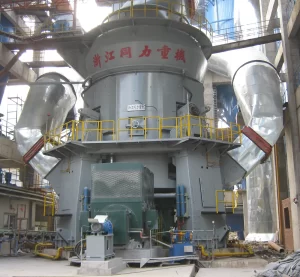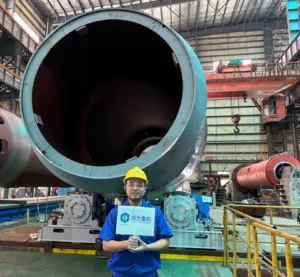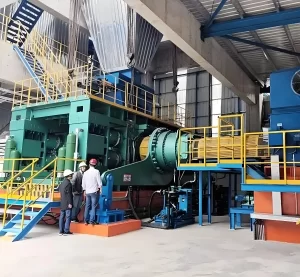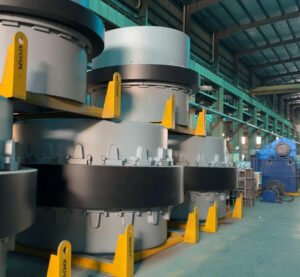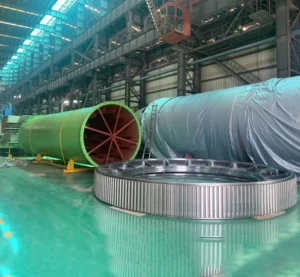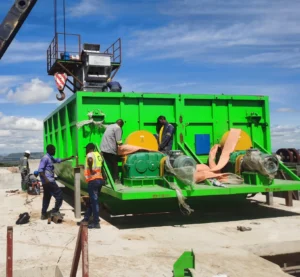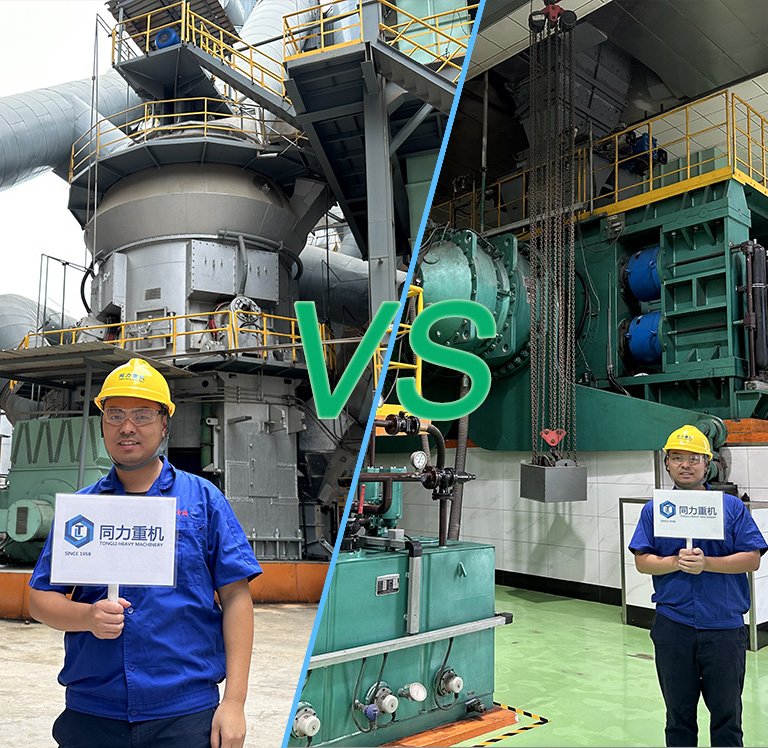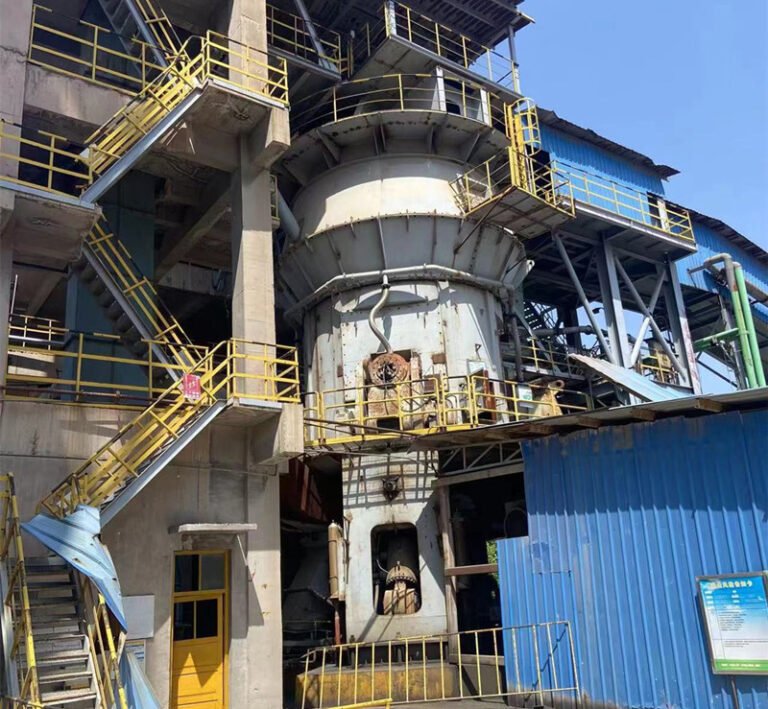
A lot of our customers are always confused between vertical roller mills and Raymond mills, although they are both called vertical mills, in essence, they are two very distinct machines in terms of cost, structure, principle, and application. So in this article, we are going to talk about what are the differences, we will introduce the details of these two machines in another article, and this article will solely emphasize the differences. We will cover 15 important aspect below:
Capital Investment Cost Aka Price Difference
So, price is what the owner cares about most. We had many customers that their first question about vertical roller mills and Raymond mills isn't about their function, but their price — because some customer their budget is very limited. In general, vertical roller mills are more expensive than Raymond mills. This is becasue vertical roller mill has more complexity, higher automation level, and integrated features like drying, grinding, and classifying while raymond mill can't install drying function.
And here's an example of the price difference, for the same material and the same production capacity, a vertical roller mill is 50–80% more expensive than a Raymond mill. For example, for the same material and a production capacity of 15 tons per hour vertical roller mill vs raymond mill:
- A Raymond mill with capacity 15t/h costs approximately $150,000 USD.
- A Vertical roller mill with 15t/h capacity costs around $300,000 USD.
Internal Structure
Raymond mill structure:

Consists of a feed device, a grinding chamber, a powder selector, a transmission system, etc. The material enters from the side feed port, is transported to the grinding roller and the grinding ring by a scraper, and the fine powder after crushing is carried by the airflow to the top powder selector for screening. Notice even though its called grinding roller but actually the size is way smaller than the vertical roller mill grinding roller, you can tell from the weight as well.
Vertical roller mill structure:

VRM usues Germany design, it is mainly composed of a base frame, a grinding table, a grinding roller device, a powder selector, an air ring system, a hydraulic system, etc. The material falls from the center of the grinding disc, and is crushed by the grinding roller as the grinding disc rotates. The airflow moves upward from the air ring, bringing the fine powder into the powder selector for classification, and the coarse powder falls back to the grinding disc for further grinding, and the fine powder is collected by the dust collector.
Comparison table structure difference between raymond mill and VRM
| Component | Raymond Mill | Vertical Roller Mill |
| Grinding Rollers | - Typically 3 to 6 rollers, arranged circumferentially and rotated by a central shaft. - Cylindrical shape, pressed against the grinding ring by centrifugal force. | - Usually 2 to 6 rollers, vertically mounted on roller arms. - Pressed onto the grinding table by hydraulic pressure. - Tire-shaped or cylindrical, with wear-resistant surface. |
| Grinding Ring / Table | - Fixed at the bottom of the grinding chamber. - Works with rollers to form an annular grinding zone. - Made of wear-resistant cast iron or alloy, needs regular replacement. | - No separate grinding ring. - Grinding table surface serves directly as the grinding area, lined with replaceable wear plates. - Flat horizontal disc with material retention ring at the edge. |
| Drive System | - Motor drives main shaft via reducer. - Main shaft rotates rollers. - Mechanical drive, relatively simple. | - Motor directly drives the grinding table via gearbox. - Rollers rotate passively via friction from the table. - Hydraulic system controls grinding pressure. |
| Classifier System | - Built-in top classifier with rotating and stationary blades. - Fineness controlled by adjusting rotation speed. - Short airflow path, directly connected to grinding chamber. | - Classifier integrated at mill top. - Part of a closed airflow system with air ring and ducting. - Uses dynamic (rotating rotor) or static classifiers with higher efficiency. |
| Feeding System | - Side feed inlet with scraper blades that rotate with the shaft to lift material under the rollers. | - Center feed inlet (via chute), material drops onto the table center and spreads outward by centrifugal force. |
| Airflow System | - Simple airflow system using external fan. - Carries fine powder through classifier. | - More complex: includes air ring (below table edge), ducts, and dust collector. - Airflow transports and classifies material simultaneously. |
| Hydraulic System | - No hydraulic system. - Roller pressure generated naturally by centrifugal force. | - Equipped with hydraulic system. - Used for roller lifting during maintenance and to apply grinding pressure. - Pressure adjustable for optimized performance. |
Production Output Capacity
Raymond mill common capacity:

- Suitable for small to medium-scale production.
- Common capacity ranges from 1 to 15 tons per hour depending on model and material.
- Best suited for materials with moderate hardness and dryness.
- Not ideal for high-moisture or large feed size materials.
- Limited by grinding chamber size and mechanical structure.
Vertical roller mill common capacity:

- Vertical Roller Mill (VRM):
- Designed for large-scale industrial production.
- Standard capacity ranges from 10 to over 200 tons per hour.
- Capable of handling large feed sizes and high-moisture materials (up to 15–20% moisture).
- Ideal for cement, slag, raw meal, coal, and other heavy-duty grinding applications.
- Scalability allows use in both small grinding plants and integrated cement production lines.
Finished Product Powder Fineness
The fineness range of the finished powder of the vertical mill is usually 80-800 mesh, with wide adjustability and good uniformity. The fineness of the Raymond mill is mostly 80-600 mesh, and the output is easily affected at higher fineness.
Vertical roller mill powder finess:
The fineness of the finished powder can be adjusted in a wide range, usually from 80 mesh to 800 mesh corresponding to a particle size of about 180 microns to 15 microns. For example in cement production, the vertical mill can grind the finished product to a specific surface area of 320-400㎡/kg about 325 mesh; when grinding slag, the fineness can reach 450-600㎡/kg about 400-600 mesh, and the fineness uniformity is good.
Raymond mill powder finess:
The fineness of the finished powder is generally 80 mesh to 600 mesh (particle size is about 180 microns to 25 microns), and the output is significantly reduced at higher fineness (such as above 600 mesh).
For example, when processing calcium carbonate, it is common to grind to 325 mesh (about 45 microns) with Raymond mill. If you need to reach 600 mesh (about 25 microns), you need to increase the grinding time and the production capacity may be reduced by more than 50%.
Product Quality
The finished product of the vertical mill has uniform fineness, cement specific surface area of 320-400㎡/kg, low standard deviation of 20%-30%, high spherical particle ratio of 30°-35°, and activity index of more than 95%, while the finished product of the Raymond mill has large fluctuations in fineness, 15%-25% higher coarse particle content, 10%-20% higher aspect ratio of angular particles, and 50%-100% higher iron impurity content.
Finished products of vertical roller mill:

- Good uniformity of fineness: The vertical mill adopts airflow classification and grinding simultaneously, and the finished product particle size distribution is narrow. For example, in cement production, the fluctuation range of the specific surface area of cement products produced by the vertical mill can be controlled within a small range, generally reaching a specific surface area of 320-400㎡/kg (about 325 mesh), and its standard deviation can be 20%-30% lower than that of Raymond mill.
- Regular particle morphology: The rolling and grinding method of the vertical mill makes the material particles mostly spherical or quasi-spherical, with good fluidity. The repose angle of slag micropowder processed by the vertical mill is generally between 30°-35°, while the repose angle of slag micropowder processed by the Raymond mill is usually between 35°-40°. In comparison, the fluidity of the vertical mill product is better, and it is more suitable for fields such as concrete and coatings that have requirements for particle morphology.
- High activity index: After slag, fly ash and other materials are ground by the vertical mill, the surface defects of the particles are few and the hydration reaction activity is improved. For example, after slag micropowder is ground by vertical mill, the 7-day activity index can reach more than 95%, while the 7-day activity index of slag micropowder processed by Raymond mill is generally around 85%-90%.
Finished products of raymond mill:

- Large fluctuation in fineness: Raymond mill is a cyclic grinding process, which is prone to over-grinding or mixing of coarse and fine particles. Taking 325 mesh calcium carbonate powder as an example, the content of coarse particles (such as larger than 45 microns) in the products produced by Raymond mill may be 15%-25% higher than that of vertical mill, and the uniformity of fineness is poor.
- More angular particles: Raymond mill uses centrifugal rolling to make the material particles more angular, with a larger specific surface area, but poor fluidity. When used in scenes such as mortar, additional grading adjustment is required. The aspect ratio of the powder particles produced by it is usually 10%-20% higher than that of vertical mill products, resulting in significantly lower fluidity than vertical mill products under the same conditions.
- The impurity content may be higher: The metal debris produced by the wear of the grinding parts of the Raymond mill, such as the grinding ring and the grinding roller, is easy to mix into the finished product. When grinding non-metallic minerals, if the iron removal process is not added, the iron content in the finished product may be 50%-100% higher than that of the vertical mill. Therefore, it is usually necessary to add iron removal processes such as magnetic separation to ensure purity.
Fields of Application
Please see the comparison table below:
| Comparison Dimension | Raymond Mill | Vertical Roller Mill (VRM) |
| Core Application Fields | Primary processing of non-metallic minerals, production of chemical fillers, pretreatment of metallurgical slags | Deep processing of cement and slag, flue gas desulfurization in power plants / coal chemical industry, high-end powder materials, metal ore and solid waste treatment |
| Typical Materials | Calcite, talc, dolomite, gypsum, kaolin, blast furnace slag, and other materials with Mohs hardness ≤ 6 | Cement raw meal / clinker, slag, limestone, pulverized coal, silica fume, lithium battery anode materials, copper slag / nickel slag |
| Finished Product Fineness Range | 80–325 mesh (commonly 100–300 mesh), e.g., calcium carbonate filler (200 mesh), gypsum powder (200 mesh) | 80–800 mesh (can reach ultrafine level D97 ≤ 5μm), e.g., cement Blaine fineness 320–450 m²/kg, slag powder 450–600 m²/kg |
| Production Capacity Scale | Medium to small-scale lines (annual output: 10,000–50,000 tons); single unit output usually 5–20 tons/hour | Large-scale industrial production (annual output: 100,000–1,000,000 tons); single unit capacity can reach 100–200 tons/hour (e.g., cement grinding) |
| Typical Industry Scenarios | - Wall putty powder (gypsum grinding at 200 mesh) - Plastic fillers (barite powder at 325 mesh) - Steel slag base filler (100–300 mesh) | - Cement plant slag grinding line (600,000 tpy or more) - Power plant limestone desulfurization powder (250–325 mesh, 600,000 tpy) - Lithium battery anode material (artificial graphite D50 = 15–20μm) |
| Equipment Suitability & Features | Low investment cost, simple structure; suitable for medium-to-low fineness and small-to-medium scale production; high sensitivity to material hardness | Lower energy consumption (15%–30% lower than Raymond mill), high classification precision; ideal for large-scale, high-fineness, and high-purity applications; high initial investment |
| Typical Industry Cases | Small to medium calcium carbonate powder plants, coating filler processing plants, steel slag recycling lines at regional steel mills | Conch Cement slag VRM line, large-scale power plant desulfurization systems, new energy battery material production lines |
Energy/Utility Consumption
Conclusion: Vertical roller mills consume less energy in large-scale production, high hardness or wet material processing (power consumption is 15%-30% lower than Raymond mills), while Raymond mills are suitable for small and medium-sized scales, low hardness and no drying requirements, but have higher unit energy consumption.
- Vertical roller mill: large-scale production, high-hardness materials (such as cement clinker), wet materials that need to be dried (such as slag), comprehensive energy consumption is 15-30% lower, especially suitable for industrial scenarios with an annual output of more than 100,000 tons.
- Raymond mill: small and medium-scale production, low-hardness materials (such as talc), no drying requirements, low initial investment but high unit energy consumption, suitable for small and medium-sized production lines with an annual output of less than 50,000 tons.
Examples:
Raymond mill example:

- Cement industry: used for grinding mixed materials (such as fly ash 325 mesh) in small cement enterprises, with power consumption of about 28-35 kWh/t and no heat consumption.
- Slag micro powder production: grinding 400㎡/kg slag micro powder, power consumption is about 45-55 kWh/t, and an additional dryer (heat consumption is about 400 kJ/kg) is required.
- Non-metallic mineral powder grinding (calcium carbonate): 325 mesh calcium carbonate powder, power consumption 25-30 kWh/t, power consumption per ton reaches 30 kWh at a capacity of 10 t/h.
Vertical roller mill example:
- Vertical mill cement industry: Large cement raw material mill (processing limestone, 80μm sieve residue ≤15%) consumes 18-22 kWh/t of electricity. If the raw material contains 5% moisture, the heat consumption is about 250 kJ/kg (using waste heat from the kiln tail), and the comprehensive energy consumption is 15-30% lower than that of Raymond mill.
- Slag micro powder production: simultaneous completion of drying (moisture ≤10%) and grinding (specific surface area 450㎡/kg), power consumption 40-50 kWh/t, heat consumption 300-350 kJ/kg, total energy consumption is 20-25% lower than Raymond mill.
- Non-metallic mineral powder grinding (calcium carbonate): Power consumption is 20-25 kWh/t at the same fineness, and power consumption per ton can be reduced to 22 kWh at a capacity of 50 t/h, which is about 25% more energy-efficient than Raymond mill.
Utility Comparison table
| Comparison Dimension | Raymond Mill | Vertical Mill |
| Specific Power Consumption (kWh/t) | Non-metallic mineral grinding: 15-30 (e.g., 325-mesh calcium carbonate) | Cement raw material grinding: 18-25 Cement clinker grinding: 30-40 Slag powder: 40-55 |
| Heat Consumption (kJ/kg) | Typically not involved (normal temperature grinding) | Drying and grinding scenario: 200-400 (e.g., slag with 8% moisture content) |
| System Efficiency | Grinding efficiency about 60-70% (mainly mechanical grinding) | Integrated grinding + drying + classification, efficiency up to 80-90% |
| Energy-saving Advantage Scenarios | Small to medium scale, low-hardness materials, no drying requirement | Large-scale production, high-hardness materials, wet materials requiring simultaneous drying |
Manufacturing Leadtime
- Raymond mill: The manufacturing cycle is usually 8-12 weeks. Due to its relatively simple structure (mechanical parts such as grinding rollers and grinding rings are highly standardized), when the spare parts of our inventory is sufficient, lead time can be shortened to 6 weeks.
- Vertical mill: The manufacturing cycle is 16-24 weeks. Large main components such as grinding table and grinding roller are metal casting, and our Tongli foundry is always full; Hydraulic systems and oil lubrication station need to be customized, and the production cycle of planetary reducers and bearings is long. It may even take more than 30 weeks to equip a large production line with a vertical mill.
Installation period and time

- Vertical roller mill: The installation time is about 4-8 weeks, first reason is because the equipment is large such as the grinding table diameter can reach 3-6 meters, the system integration is high (needs to connect to hot air ducts, hydraulic systems, dust removal equipment, etc.), and especially since it is heavy duty equipment, it can not simply put on the ground, a solid concrete foundation need to be poured with reinforcement bar and anchor bolts, the construction and commissioning process is more complicated.
- Raymond mill: The installation period is short, usually 2-4 weeks, because the structure is relatively simple (mainly composed of independent components such as the main machine, fan, and classifier), and small and medium-sized equipment does not require complex foundation construction, suitable for rapid production.
Maintenance Cycle
Vertical roller mill
The grinding roller and grinding disc lining have a long life (8000-10000 hours), but replacement requires professional equipment and complex maintenance; the hydraulic system, hot air furnace, etc. need to be regularly tested for sealing and heat exchange efficiency, which is suitable for large-scale continuous production.
Raymond mill
Maintenance is mainly for wearing parts such as grinding rollers and grinding rings, which have a high replacement frequency (lifespan of about 2000-3000 hours); the transmission system needs frequent lubrication, a short maintenance cycle (maintenance every 500 hours), and low maintenance difficulty.
Lifespan & Wear Parts
Like before we like to be straight forward, here is the conclusion reagrding this matter: The life of the core components of the vertical roller mill (grinding roller 8000-10000 hours, grinding disc liner 10000-15000 hours) is much longer than that of the Raymond mill (grinding roller 2000-3000 hours, grinding ring 2000-3000 hours), and the maintenance cost per ton of material is 40% lower, which is more suitable for large-scale high-load production scenarios with long-term continuous operation.
Wear mechanism comparison:
- Raymond mill: The grinding roller uses centrifugal force to crush the material, forming point contact friction with the grinding ring. The wear is concentrated on the edge of the contact surface. Especially when processing high-hardness materials such as quartz sand, the life of the grinding roller can be shortened to 1500 hours; in the grinding of non-metallic minerals, the grinding ring is replaced about 4-6 times a year when grinding 325 mesh calcium carbonate.
- Vertical mill: Adopting the material bed grinding principle, the grinding roller and the grinding disc liner are indirectly squeezed through the material layer, and the wear is evenly distributed. When the high chromium cast iron liner is used to grind cement clinker (Mohs hardness 6-7), the annual wear amount is ≤1.5mm; in the production of slag micro-powder, the grinding roller life can reach more than 8000 hours (3 times higher than Raymond mill).
The impact of structural design on life

- Raymond mill: The open grinding chamber leads to large dust leakage, which accelerates the wear of bearings and transmission parts. The fan impeller needs to be repaired by surfacing welding every 800 hours due to long-term erosion and wear; the design life of a small Raymond mill is about 5-8 years (30,000 cumulative hours of operation).
- Vertical mill: The closed grinding chamber is equipped with an efficient dust collection system, the dust leakage rate is less than 0.1%, and the bearing life is extended to 20,000 hours; large vertical mills such as Tongli LM5640K have a design life of 10-15 years and a cumulative operation of more than 60,000 hours. The grinding disc liner can be turned over to extend its life by 20%.
Typical application scenario maintenance cost in USD US dollar
For producing cement:
- Raymond Mill: When grinding fly ash, the roller life is 2500 hours, replaced 3 times a year, the single repair cost is about 2,800 USD, and the annual maintenance cost is about 8,400 USD.
- Vertical Mill: When processing limestone, the grinding disc liner life is 12000 hours, replaced once every 3 years, and the single repair cost is about 21,000 USD; the comprehensive maintenance cost per ton of material is 0.11 USD/ton, which is 40% lower than the 0.18 USD/ton of Raymond Mill.
For slag micro powder production:
- Raymond Mill: When grinding 400㎡/kg slag, the grinding ring life is 2000 hours, the life of the dryer lifting plate is 1500 hours, and the annual maintenance cost is about 16,800 USD.
- Vertical Mill: Synchronous drying and grinding of 8% moisture slag, roller life of 8000 hours, hot blast furnace refractory brick life of 5000 hours, annual maintenance cost of about 11,200 USD, 33% lower than Raymond Mill.
Maintenance cost comparison conclusion:
Raymond mill is suitable for small and medium-sized production, with a machine life of 5-8 years, maintenance cost of 0.14-0.21 USD/ton, frequent replacement of wearing parts but low cost per replacement (such as 2,800 USD/time for roller replacement). Vertical mill is suitable for large-scale continuous production, with a roller life of 4 times that of Raymond mill, and maintenance cost per ton of material can be reduced to 0.07-0.14 USD/ton. Although the replacement cost of grinding disc liner is high (21,000 USD/time), the long-term operating cost advantage is significant (annual maintenance cost is 5,600-8,400 USD lower than Raymond mill).
Feed Size & Moisture Content Capacity
Feed size comparison:
| Category | Vertical Mill (VRM) | Raymond Mill |
| Typical Feed Size Range | Usually ≤ 50 mm (some large-scale VRMs can handle up to ≤ 100 mm) | Typically ≤ 30 mm (certain models can handle up to ≤ 50 mm) |
| Typical Application Example | Cement raw meal grinding can directly process large limestone blocks (≤ 80 mm) | Fine materials like fly ash and talc need to be pre-crushed to ≤ 30 mm |
| Advantageous Use Cases | Suitable for large particle feed, reducing the need for pre-crushing and saving system energy | Requires additional crushers for medium to coarse feed, leading to higher system complexity |
Moisture handle comparison:
| Category | Vertical Mill (VRM) | Raymond Mill |
| Moisture Handling Range | Dry grinding: ≤ 1% With built-in drying: up to ≤ 15% (e.g., slag with 8% moisture can be processed directly) | Dry grinding: ≤ 1% With external dryer: up to ≤ 8% (Pre-drying is required when moisture exceeds 3%) |
| Drying Mechanism | Integrated hot air system allows simultaneous grinding and drying (thermal efficiency 70%–80%) | Requires separate drying equipment (e.g., tube bundle dryer) (thermal efficiency around 50%–60%) |
| Typical Applications | Slag grinding (can handle 8% moisture directly), cement raw material grinding (clay with ≤10% moisture) | Fly ash (moisture ≤1%), calcium carbonate (dry grinding); high-moisture materials must be pre-dried |
Summary of core differences in feed size and moisture handly capability:
1. Feed particle size adaptability:
Vertical roller mills can directly process large-size materials (such as limestone and clinker) with their larger feed port size and grinding pressure design, while Raymond mills are limited by the gap between the grinding roller and the grinding ring, and the feed particle size must be strictly controlled below 30 mm, otherwise it is easy to cause equipment jams.
2. Moisture handling capacity:
The drying function of the vertical mill is an integrated design, and the hot air is in direct contact with the material in the mill, which is suitable for processing wet materials (such as clay with 10% moisture content) and reduces the investment in independent drying equipment; when Raymond mills process materials with moisture content greater than 1%, additional dryers are required (such as slag drying requires the addition of vulnerable parts such as lifting plates), which not only increases energy consumption, but also increases the complexity of maintenance.
All in a nut shell:
- Vertical cement clinker grinding mills: Suitable for large-scale production of materials with high moisture content (such as 8%-15%) and large particle size (≤100 mm), such as cement raw material preparation, slag micro-powder processing, etc.
- Raymond mill: It is more suitable for grinding non-metallic mineral powders with low moisture content (≤1%) and small and medium particle sizes (≤30 mm), such as talcum powder, calcium carbonate, etc. For materials with high moisture content, a drying pretreatment step is required.
Drying & Grinding Integration
Conclusion: Vertical mill can process materials with 10%-15% moisture content and achieve a thermal efficiency of 70%-80% through integrated drying and grinding design, while Raymond mill requires independent drying equipment to process materials with moisture content ≤1%, with a thermal efficiency of only 50%-60% and energy consumption of more than 30%. Now let me explain it in detail:
Vertical roller mill can intergrate drying function:

It adopts an integrated design of drying and grinding, with a built-in hot air circulation system. The hot air directly enters the grinding disc area to contact the material, and quickly evaporates the moisture through heat exchange. The moisture processing capacity is as high as 10%-15%. For example, when processing wet materials such as slag and clay with a moisture content of 12%, it can be directly put into the mill to complete drying and grinding without the need for pre-drying process. The drying process is carried out simultaneously with grinding, and the material stays in the mill for a short time (only 2-3 minutes). The thermal efficiency can reach 70%-80%, and the hot air temperature can be precisely controlled (usually 300-400℃) to avoid overburning of materials or residual moisture. In addition, the vertical mill's grading system is seamlessly connected with the drying and grinding process, which can screen qualified finished products in real time to ensure that the moisture content of the finished products is stable below 0.5%.
Raymond mill can not intergrate drying function:

Drying and grinding functions are independent of each other. Under normal working conditions, it is only suitable for grinding dry materials with a moisture content of ≤1%. If high-moisture materials (such as slag moisture content >3%) are processed, a separate dryer (such as a tube dryer or a rotary dryer) is required to reduce the moisture content of the material to a safe range before grinding. This not only increases the equipment investment cost (about 20%-30% of the total investment), but also leads to a significant increase in system energy consumption, and the thermal efficiency is only 50%-60%. The drying and grinding links are separated, and the materials need to be transported multiple times, which is prone to dust pollution. In addition, the overall production process is lengthy and the number of system failure points increases. For example, when processing gypsum with a moisture content of 8%, the Raymond mill must first reduce the moisture content to 1% through a dryer before grinding it. Compared with the vertical mill, it consumes more than 30% more heat and electricity. In addition, due to the heat loss of the drying equipment, the moisture content of the finished product fluctuates greatly and is difficult to control stably.
Degress of automation: System Complexity & Automation Integration
Conclusion: The vrm cement mill uses a computer-based DCS central control system to achieve full-process visual operation (including one-button start and stop and real-time adjustment of current, pressure and other parameters), while the Raymond mill relies on an LCD screen for basic parameter display and limited manual operation, and its degree of automation and intelligence is significantly lower than that of the vertical mill.
Vertical roller mill automation level:

- Automation integration: The distributed control system (DCS) is used to monitor hundreds of parameters such as roller pressure, temperature, air volume, etc. in real time, automatically adjust the feed amount, hot air temperature and grading system, and achieve "one-button start and stop", with an automation rate of more than 95%; some high-end models also integrate AI predictive maintenance functions, which can predict equipment wear through sensor data and connect to the industrial Internet platform for energy consumption optimization and production scheduling.
- System complexity: The equipment structure is complex, consisting of multiple subsystems such as the main mill, hydraulic system, hot air furnace, powder selector, dust collector, etc., and the pipelines and sensors are precisely arranged; the debugging is difficult, and the parameters such as the gap between the roller and the grinding plate and the hot air speed need to be strictly calibrated, and the debugging cycle is as long as 8-12 weeks; during maintenance, the hydraulic oil contamination needs to be regularly tested and the sensor calibrated, which usually requires a professional engineer team to operate.
Raymond mill automation level:

- Automation integration: Programmable logic controllers (PLC) are mostly used, which can only monitor basic parameters such as current and temperature. Feeding speed and classifier speed need to be adjusted manually, and the automation rate is about 70%-80%; lack of intelligent diagnosis and big data analysis functions, fault warning relies on manual inspection, and energy consumption adjustment also requires manual intervention.
- System complexity: The equipment structure is relatively simple, mainly composed of the main engine, fan, and classifier, with a short installation cycle (about 2-4 weeks); the debugging focuses on the matching of the grinding roller speed and the classifier frequency, and the technical threshold is low; daily maintenance is mainly mechanical parts lubrication and replacement of wearing parts, which can be completed by ordinary technical workers, the overall system has fewer failure points, and the maintenance cost is low.
Comparison table:
| Comparison Dimension | Vertical Mill | Raymond Mill |
| Automation Control System | Distributed Control System (DCS), full-process visual operation via computer | Programmable Logic Controller (PLC) or simple electrical control system, basic LCD operation |
| Parameter Monitoring Capability | Real-time monitoring of hundreds of parameters (roller pressure, temperature, air volume, etc.) | Monitoring of basic parameters (current, temperature, etc.) only |
| Automated Adjustment Functions | Automatic adjustment of feeding amount, hot air temperature, classifier speed; supports "one-key start/stop" | Manual adjustment of feeding speed and fan air volume required; human intervention dominant |
| Intelligent Integration Features | Integrated with AI predictive maintenance, fault diagnosis, and industrial internet platform docking | Lacks intelligent diagnosis; relies on manual inspection |
| System Complexity | Complex structure (combination of grinding table/rollers/hydraulic/hot air/classifier subsystems) | Simple structure (mainly grinding rollers/rings, fans, classifiers) |
| Debugging & Maintenance Difficulty | Debugging cycle: 8-12 weeks; requires professional engineers for precise parameter calibration | Debugging cycle: 2-4 weeks; maintenance achievable by ordinary technicians |
| Degree of Human Intervention | Human intervention rate < 5%; suitable for unmanned continuous production | Human intervention rate 20%-30%; relies on operational experience |
| Typical Application Scenarios | Large-scale cement production lines, slag micro-powder plants (annual output > 100,000 tons) | Small-to-medium non-metallic mineral powder plants, coating filler workshops (annual output < 50,000 tons) |
Operational Parameters (table speed, roller pressure, classifier efficiency)
For this topic we do not have a conclusion, but we can list the characteristics here for you the owner to determine:
Grinding disc speed and grinding roller pressure

- The vertical mill adopts the "low speed and high pressure" mode: the grinding disc speed decreases as the diameter increases (such as the speed of the Φ5m vertical mill is about 25 rpm), and the high pressure (up to 30 MPa) is applied through the hydraulic system. The material bed grinding principle is used to achieve efficient crushing, which is suitable for high-hardness materials (such as slag and cement clinker).
- The Raymond mill is a "high speed and low pressure" mode: the grinding roller rotates around the grinding ring at high speed (linear speed 10-20 m/s), relying on spring mechanical pressure (maximum 2 MPa), and the material is crushed by the grinding roller and grinding ring. It is more suitable for medium and low hardness materials such as quartz sand and calcite.
Powder selector efficiency and product fineness
- The vertical mill is equipped with a dynamic powder selector (such as Sepax type), which adjusts the rotor speed through frequency conversion to accurately control the fineness of the finished product. D90 (90% passing particle size) can be flexibly adjusted within the range of 15-45μm, which is suitable for high value-added micro powder production (such as slag micro powder S95 grade).
- Raymond mills mostly use static powder selection or simple impeller powder selection machines. The fineness adjustment depends on the fan air volume, with low precision. D90 is usually greater than 45μm, which is suitable for coarse powder processing such as ordinary construction sand and fillers.
Energy consumption and process adaptability
- Vertical mills have significant energy consumption advantages: due to the high grinding efficiency of the material bed and the recycling of hot air, the unit energy consumption when grinding cement is 15%-30% lower than that of Raymond mills, and the drying-grinding-powder selection process can be completed simultaneously (no additional drying equipment is required when processing materials containing water).
- Raymond mills have high energy consumption: mechanical friction loss is large, and the drying capacity is limited. When processing wet materials, an independent dryer is required, and the overall process energy consumption increases.
Vertical Mill vs. Raymond Mill: Technical Parameter Comparison table
| Parameter | Vertical Mill (VRM) | Raymond Mill |
| Grinding Table Speed | 20–50 rpm (adjusted based on table diameter; larger mills run at lower speeds) | 100–300 rpm (determined by the peripheral speed of grinding rollers rotating around the ring) |
| Grinding Pressure | 5–30 MPa (automatically adjusted by hydraulic system; directly related to material hardness and target output) | 0.5–2 MPa (applied by springs or mechanical force; manual adjustment required) |
| Classifier Efficiency | 85%–95% (high-efficiency dynamic classifier with variable frequency control; product fineness D90 = 15–45μm) | 60%–80% (static or basic dynamic classifier; typical product fineness D90 = 45–100μm) |
| Feeding Capacity | 50–500 t/h (supports large-scale industrial production) | 5–50 t/h (mainly for small to medium-sized operations) |
| Hot Air Temperature | 200–400°C (suitable for drying materials with up to 15% moisture) | 80–150°C (limited drying capability; suitable for materials with ≤5% moisture) |
| Specific Energy Consumption | 28–45 kWh/t (when grinding cement) | 40–60 kWh/t (15%–30% higher energy consumption under similar conditions) |
Summary: When to choose which?
Up to this point I think we have explained it clear what are the difference, and below is a table, if you are not sure about which mahcine you should choose, please check the material table below where we listed the hardness, product finess and whether it can be ground with vrm or raymond mill.
| Material | Hardness (Mohs) | Finished Powder Fineness | Raymond Mill | Vertical Roller Mill | Recommended Mill |
| Limestone | 3.0 – 4.0 | 80–325 mesh | ✅ | ✅ | ✅ Both (VRM for large scale) |
| Gypsum | 2.0 – 2.5 | 100–325 mesh | ✅ | ✅ | ✅ Both |
| Talc | 1.0 | 200–600 mesh | ✅ | ✅ | ✅ Raymond for fine powder |
| Barite | 3.0 – 3.5 | 200–400 mesh | ✅ | ✅ | ✅ VRM for industrial use |
| Calcite | 3.0 | 200–400 mesh | ✅ | ✅ | ✅ Raymond for moderate use |
| Cement Clinker | 6.0 – 7.0 | 80–100 mesh | ❌ | ✅ | ✅ Vertical Roller Mill |
| Slag | 5.0 – 6.5 | 80–325 mesh | ❌ | ✅ | ✅ Vertical Roller Mill |
| Bauxite | 1.0 – 3.5 (varies) | 200–400 mesh | ✅ | ✅ | ✅ Depends on production scale |
| Petroleum Coke | 5.0 – 6.0 | 200–325 mesh | ❌ | ✅ | ✅ Vertical Roller Mill |
| Coal | 2.5 – 3.0 | 100–325 mesh | ✅ | ✅ | ✅ VRM for drying + grinding |
| Marble | 3.0 – 4.0 | 200–600 mesh | ✅ | ✅ | ✅ Raymond for fine finish |
| Dolomite | 3.5 – 4.0 | 200–325 mesh | ✅ | ✅ | ✅ Both |
| Quartz | 7.0 | 200–400 mesh | ❌ | ✅ | ✅ Vertical Roller Mill |
| Feldspar | 6.0 – 6.5 | 200–325 mesh | ❌ | ✅ | ✅ Vertical Roller Mill |
| Kaolin | 2.0 – 2.5 | 300–800 mesh | ✅ | ✅ | ✅ Raymond for ultra-fine powder |
| Bentonite | 1.0 – 2.0 | 200–600 mesh | ✅ | ✅ | ✅ Raymond preferred for fineness |
| Phosphate Rock | 5.0 – 5.5 | 200–325 mesh | ❌ | ✅ | ✅ Vertical Roller Mill |
| Iron Ore | 6.0 – 7.0 | 100–300 mesh | ❌ | ✅ | ✅ Vertical Roller Mill |
| Manganese Ore | 5.0 – 6.0 | 100–300 mesh | ❌ | ✅ | ✅ Vertical Roller Mill |
| Fly Ash | ~2.0 | 300–600 mesh | ✅ | ✅ | ✅ VRM for large volume |
| Graphite | 1.0 – 2.0 | 200–600 mesh | ✅ | ✅ | ✅ Raymond for high fineness |
| Zeolite | 3.0 – 5.5 | 200–400 mesh | ✅ | ✅ | ✅ Depends on feed size |
| Diatomite | 1.0 – 1.5 | 325–800 mesh | ✅ | ✅ | ✅ Raymond for fine powder |
| Dolomitic Limestone | 3.5 – 4.5 | 100–325 mesh | ✅ | ✅ | ✅ Both |
Conclusion:
Choosing between a Raymond mill and a vertical roller mill depends on your production needs and material characteristics; Raymond mills are more cost-effective and suitable for smaller-scale operations with softer, drier materials, while vertical roller mills offer higher capacity, better energy efficiency, and can handle harder or wetter materials, making them ideal for large-scale industrial use despite the higher initial investment as simple as that. In our next article we will discuss about cement grinding ball mill, if you are interest please click on this link here.

